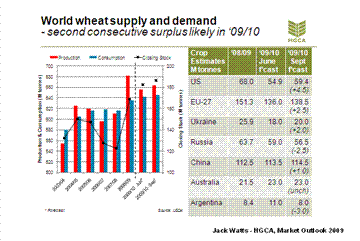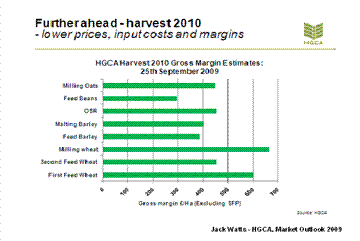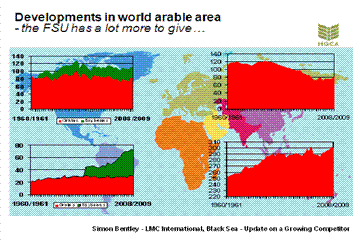
HGCA 2009 Outlook Conference Summary
- Tuesday October 13, 2009
This analysis featured in the October 13, 2009 issue of the HGCA's MI Prospects, Volume 12, Issue 8
The following summarises the presentations at last week's HGCA Outlook Conference. View full set of papers on www.hgca.com.
Jack Watts - HGCA
Market Outlook 2009/10
While uncertainty in financial markets has influenced grain and oilseed prices over the last 12 months, increasing confidence over general economic conditions has meant fundamentals are re-emerging as the dominant drivers. For wheat, last year's record world crop and surplus followed by the prospect for another large crop this year, has driven prices closer to intervention levels. For feed grains, a production surplus to consumption in the last two years has been followed by a projected deficit this year although the forecast size of this deficit has been declining. The price spread between international wheat and feed grain prices has narrowed.
continue
But global grain consumption, particularly for feed grains, continues to increase despite the recession. While the global stocks-to-use ratio for wheat has moved well above a critical level, that for maize remains close to it. Major grain exporters harvested less this year but began the season with greater stocks. Particularly critical for international markets is whether the Russian government releases stocks it cumulated last year. World trade will be lower as major North African and near Asian importing countries harvested much improved domestic crops.
Given a smaller but still relatively large wheat crop this year, the EU is estimated to export 15Mt, 6Mt less than last season. Non-EU exports by France and Germany will be critical for this.
The UK balance sheet suggests the need for exports of 1.8 to 2.2Mt but projected use is uncertain in the context of a potential cut in starch use, increase in ethanol production needs and substitution of barley in feed rations. In aggregate, this season's UK crop quality is more 'normal' but also more variable. This will mean selection will be more critical. But improved confidence in the availability of UK quality milling wheat has already eroded last year's quality premiums. Ultimately, exchange rates may have a deterring role for price prospects.
For barley, the UK is faced with the prospect of a much larger crop at a time when an EU surplus is developing. And, while the malting barley market appears oversupplied, the feed market is more dependent on the maize situation and demand for ethanol feedstock. Both the US and the EU have ambitious agendas. And scheduled ethanol investment in the UK could have significant implication for the dynamics of the feed market particularly for feed wheat.
Record global oilseed production is expected this year with a record US soyabeans crop and the expected recovery in South American output early in 2010. But demand for vegetable oil continues to grow and prices have been relatively stable this year. Another record EU oilseed crop is forecast but crushing is also expected to set a record.
Looking ahead to 2010 harvest, costs, prices and gross margins appear to be lower with wheat prospects favoured over barley.
continue
Martin Redfearn - Barclays
Economic Crisis & UK Agriculture
This review suggested that the supply of farm credit from traditional lenders had not been materially affected by last year's financial crisis. Both lenders and borrowers in the agricultural field are relatively conservative, while the debt market crisis has been over aggressive lending and borrowing practices. Lending confidence is seen as returning to the market as evident by the narrowing of the spread between the LIBOR and bank's prime rates. Long-term prospects are not seen to have been affected by the recession, but minor changes in consumer buying may emerge. The impact of the recession may not be felt by farmers as much as by others, but expected lenders will continue to test their business plans robustly.
Simon Bentley - LMC International
Black Sea - Update on a Growing Competitor
continue
This analysis highlighted the role the Black Sea area and its hinterland played in providing swing capacity for international grain and oilseed markets. While there is very substantial amount of under-utilized farm land in the area, rail infrastructure serving areas far from tide water is poor and expensive. This is a long-term challenge. More immediate is concern over the disposition of surplus grain accumulated last year as a result of the success of Russia in responding to a rising market last year. Much of this is held by government, adding to uncertainty. For oilseeds, expansion in crushing capacity has been pushing oilseed production in some areas to a level that is not agronomical sustainable in a rotational context.
Marina Simonova - CRU International
Fertilizer markets - where will they go next?
This paper outlined the dynamics of fertilizer markets from manufacturer through to the retail farm market place. In the case of nitrogenous fertilizers, lower natural gas prices have been the main cause for a fall in prices. It is anticipated that 'wait and see' attitudes will gradually result in demand recovery. For phosphate prices appear to have found some stability at current levels, but for potash something of a standoff between producers and consumers, manufacturers and farmers is apparent.
Susanna May - Defra
Global Race for Food Security
This paper highlighted the challenges of meeting the requirement of consumers and the environment in addressing the issue of food security, the profile of which has been raised by higher retail food prices. A Defra assessment suggests this can best be resolved by relying on globally diverse sources of food supply. Defra sees an improvement in global food availability since the 1990s but still foresees challenges including equitable distribution and climate change.
Tom Hind - NFU
The Campaign for the Farmed Environment
This voluntary campaign aims to meet the concerns of environmentalists over the demise of set-aside. By working with existing environment partners, it is planned to select opportunities that maximize environmental benefits. On an individual basis, reliance will be placed on using conventional and trusted farm advisors. Target and monitoring systems are seen as important to ensure the support of environmental interests. And it will be necessary for everyone to participate if the scheme is to work.
David Walker (001) 780 434 7615
top of page